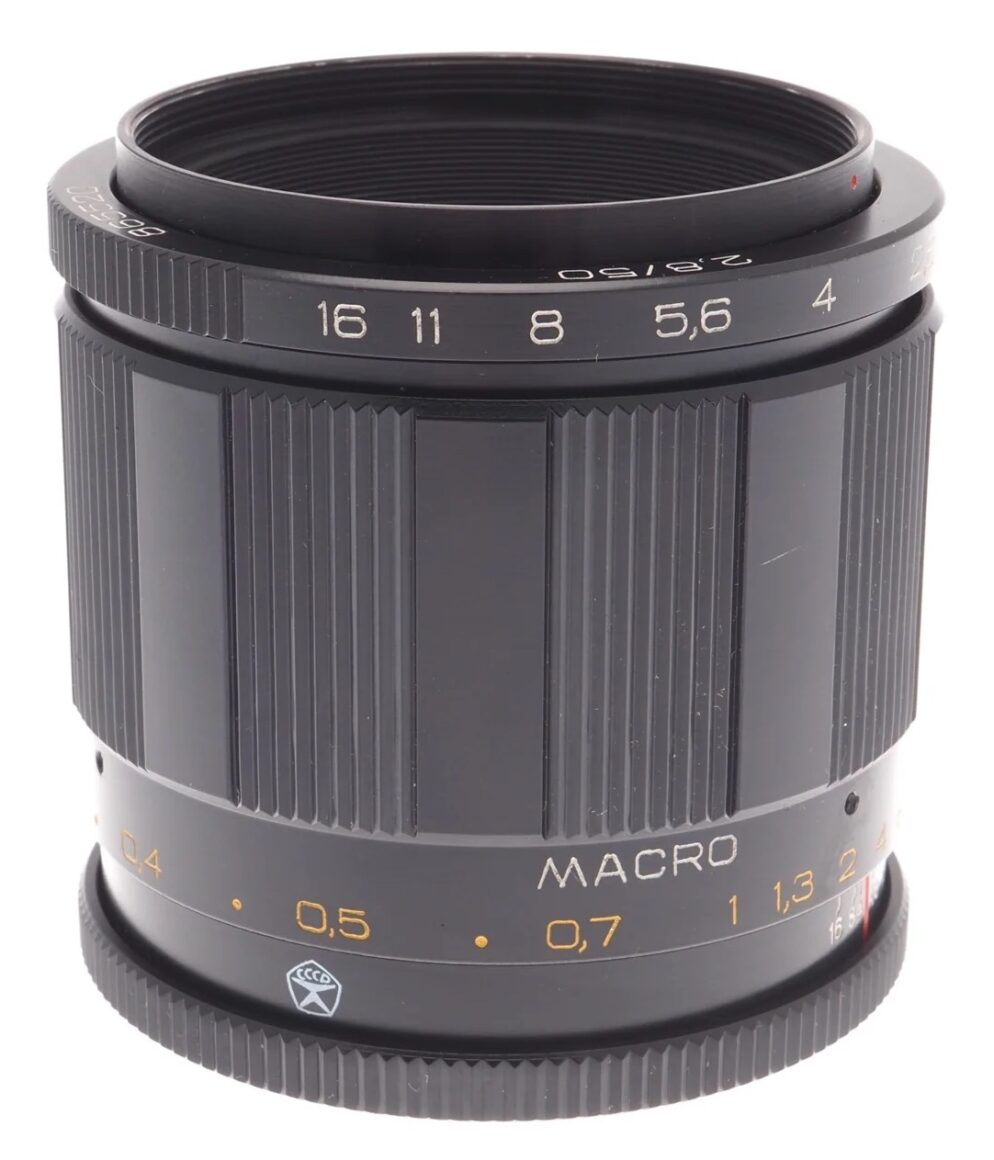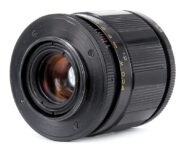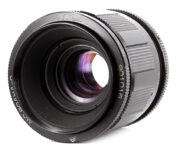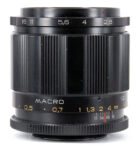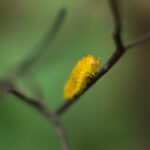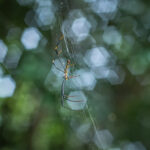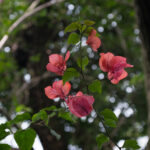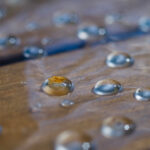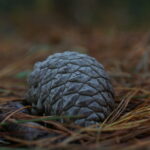Volna-9 50mm F/2.8 MC Macro
akaВОЛНА-9 50mm F/2.8 МС MACRO
Macro lens • Film era • Discontinued
- Announced:
- · 1984
- Production status:
- ● Discontinued
- Country of design:
- · USSR (Union of Soviet Socialist Republics)
- Original name:
- · МС ВОЛНА-9 2,8/50 MACRO
- Class:
- · Fast full-frame macro lens
- System:
- · Zenit M42 (1965)
Abbreviations
| MC | Multi-layer anti-reflection coating is applied to the surfaces of lens elements. This anti-reflection coating increases light transmission, eliminates flare and ghosting, and maintains color consistence among all lens models. |
| MACRO | Macro lens. Designed specially for shooting close-ups of small subjects but can be also used in other genres of photography, not necessarily requiring focusing at close distances. Learn more |
Specification
| Optical design: | |
| 35mm full frame | |
| 50mm | |
| F/2.8 | |
| 6 elements in 5 groups (Double Gauss derivative) | |
| M42 [45.5mm] | |
| 46.8° (35mm full frame) | |
| Diaphragm mechanism: | |
Diaphragm type: | Preset |
Aperture control: | Aperture ring |
| 6 (six) | |
| Focusing: | |
| 0.24m | |
| 0.122m | |
| 1:2 | |
Focusing modes: | Manual focus only |
Manual focus control: | Focusing ring |
| Physical characteristics: | |
| 340g | |
| ⌀64.5×68mm | |
| Accessories: | |
| Screw-type 52mm | |
| Not required | |
| <No data> |
Source of data
- Manufacturer's technical data.
Manufacturer description
The photographic lens "МС Волна-9" is designed as an interchangeable lens for the "Зенит"-type SLR cameras with a curtain shutter and manual aperture control.
The lens is used both for shooting infinitely distant objects, and for macro photography from a distance of 0.24 m (magnification ratio 1:2).
The lens is recommended for shooting architectural details, landscapes, small animals and insects, shooting in museums, and for reproductions, on black and white and color film.
The lens provides good image quality at all apertures and at all shooting distances, and allows you to shoot in low or artificial light or with short exposures.
Light transmission: 0.85. Resolving power, mm-1: at the center of the field: 42, at the edges of the field: 30.
From the "СОВЕТСКОЕ ФОТО" (No. 04, 1985)
THE PLANT PRESENTS:
The first domestic macro lens "МС Волна-9", released by the production and technical association "Рубин", is designed for shooting a wide range of both distant and nearby objects. It is intended as a universal interchangeable lens for SLR cameras such as "Zenit", "Praktica", "Yashica", "Cosina", "Asahi-Pentax" (models SV, SL, SP) and others, having an M42x1 screw mount and a flange focal distance of 45.5mm.
With an adapter ring, the lens can also be mounted on cameras such as "Almaz", "Asahi Pentax" (K and M series), "Chinon", "Ricoh" and others that have a bayonet ("K" type) lens mount.
LENS-DB: In 1987, a small batch of the "МС Волна-9К" was produced with the Pentax K mount, but it never reached mass production.
Various domestic standard lenses for small-format cameras have an average focusing limit of 0.65m ("Индустар-50-2") to 0.45m ("МС Волна-4"), and the "МС Индустар-61Л/З" lens has a focusing limit of 0.3m. However, even the latter is of little use for macro photography due to greatly increasing aberrations, especially at the edge of the frame. A distinctive feature of the presented lens is the ability to take macro photographs of objects from a distance of 0.24m, while the magnification ratio is 1:2, without the use of extension rings. At this distance, the minimum distance from the object to the surface of the first lens element is only 122mm and the linear field of view is 87mm, while maintaining high resolving power in the center and at the edge of the image field.
A six-element optical formula was designed for the optical system of a photographic lens intended for shooting both infinitely distant and nearby objects, guaranteeing high image quality over the entire range of shooting distances and over the entire field. When developing the lens, special attention was paid to the correction of aberrations over the field in order to improve frequency-contrast characteristics. Good correction of spherochromatic aberration was achieved, which determines the resolving power in the center. High-quality СТК-9, ТФ-3 and ТФ-4 glasses are used to manufacture lenses.
The lens has good smoothness of rotation of the focusing and aperture rings. For ease of use, a mechanism for presetting of the aperture has been introduced, due to which viewing and focusing are performed with the aperture fully open, i.e. with the greatest image brightness and the smallest depth of field. Presetting of the aperture required for shooting and its full opening during focusing are performed by one ring.
The lens has a special anti-reflective coating, as indicated by its "МС" marking. The multi-layer anti-reflective coating improves the quality of the image and increases its contrast by increasing the integral light transmission and reducing the scattering of light.
Mechanically, the "МС Волна-9" lens is made at modern aesthetic and ergonomic levels. The outer frame of the lens reliably protects the front element, being also an effective lens hood, eliminating the possibility of accidental mechanical damage to the outer surface of the lens element. The barrel allows the use of various attachments: light filters, ОТЗ reversing rings, multiprisms, etc. When shooting with a magnification of 0.5X, astigmatism and spherical aberration and slightly higher than for "infinity", so it is recommended to stop down the aperture to medium values.
The lens is designed to operate at temperatures from -15 to +45° C.
EDITORIAL COMMENTS:
We will not list in detail all the types of photography for which this lens can be used. First of all, it will certainly be of interest to photographers involved in macro- and microphotography, various reproduction works. It is also useful for those who photograph architecture, works of art, since it allows you to get high-quality pictures of the details and elements of the subject without additional accessories. Well, how often does a reporter use a macro lens in his daily work?
Photojournalist of the magazine "Советский Союз" V. Reznikov claims that a macro lens often replaces his standard one.
"I have to do reports about researchers, scientists," says V. Reznikov, "I shoot both in laboratories and in the field. A macro lens allows you to take general photographs and quickly move on to shooting small objects, for example, after taking a portrait of a scientist, immediately start shooting through the eyepiece of a microscope, and using a special adapter ring, get an image of the object on film at a scale of 1:1. When working in the field, you have to limit the set of interchangeable optics and accessories, but I always take a macro lens with an adapter ring and a 2x tele-extender with me and have never regretted it.
It should also be noted that the magnification ratio at a distance of 0.24m for the МС Волна-9 lens with the К-1 teleconverter is 1:1.
The aperture presetting ring is located at the front part of the МС Волна-9 lens and, to preset the F-value, it is necessary to slightly push the ring towards the camera and turn it until the number aligns with the red dot. Of course, it would be more convenient to have a "jumping" aperture and set its values through 1/2 marks, but so far the manufacturers have offered only this design. The development of a "jumping" aperture mechanism is underway for the next model.
The testers noted good focusing smoothness. The focusing ring has a 30mm thickening with a large sector longitudinal notch. This allows for a stable and comfortable grip on the barrel with the fingers of the right hand. However, greater comfort in operation is noted in foreign analogues due to the outer rubber ring with a cross-shaped knurling. Probably, it is not difficult to equip a domestic lens with a similar rubber ring.
The distance scale applied to the focusing ring has, in addition to digital values, intermediate points, which correspond to distances of 0.32, 0.37, 0.45 and 0.6m. The image scale values are applied above the scale: 1:4, 1:3, 1:2.
However, precise setting of the required image scale is difficult, since there are no marks on the barrel, and this is not mentioned at all in the technical description. During testing, it was necessary to recalculate the image scale based on the linear movement of the optical block. The plant designers explained that in order to accurately set the required image scale, it is necessary to take a segment from the borders of two numbers and divide it in half. The manufacturers missed the opportunity to use the side surface of the retractable part of the lens barrel. Here, it would have been appropriate to place the image scales, taking into account the attachment of domestic extension rings.
Reading the depth of field on the scale applied to the fixed part of the lens barrel is more convenient than on foreign macro lenses. This is explained by the small linear movement of the focusing ring by about 3mm. Therefore, the ability to control the depth of field is preserved at all values of the distance scale.
From the editor
The lens was produced by the Lytkarino Optical Glass Plant (USSR). First shown at the Soviet wholesale fair in 1984.
Each of the 6 aperture blades has two edges, so the opening has an unusual star shape at all apertures except F/2.8 and F/16.
To pre-set the aperture, at F/16 setting, move the aperture ring towards the focusing ring, set the desired aperture, and then release the ring.
This lens would benefit from an aperture of F/32, since macro lenses have a narrow depth of field even when stopped down a lot.
Lenses with similar focal length
| ■M42 mount (14) | |||||||||
| Asahi Super-Macro-Takumar 50mm F/4 [391, 43910, 43911] • 1:2 | A | 4 - 3 | 0.23m | ⌀49 | 1966 ● | ||||
| Asahi Macro-Takumar 50mm F/4 [367, 43670] • 1:1 | P | 4 - 3 | 0.21m | ⌀49 | 1964 ● | ||||
| Asahi Super-Multi-Coated Macro-Takumar 50mm F/4 [43912] • 1:2 | A | 4 - 3 | 0.23m | ⌀49 | 1971 ● | ||||
| Chinon 50mm F/1.7 Multi Coated Macro • 1:3 akaAuto-Alpa 50mm F/1.7 Multi-Coated akaPorst Color Reflex 50mm F/1.7 MC Macro F | A | 6 - 5 | 0.27m | ⌀52 | ● | ||||
| Chinon MCM Auto 55mm F/1.7 Multi Coated Macro akaPorst Color Reflex MCM 55mm F/1.7 Multi Coated Macro | A | 6 - ? | 0.28m | ⌀52 | ● | ||||
| Fuji Photo Film EBC Fujinon 55mm F/3.5 Macro • 1:2 | A | 5 - 4 | 0.24m | ⌀49 | ● | ||||
| Kern Macro-Switar 50mm F/1.9 • 1:3 | A | 8 - 5 | 0.27m | ⌀52 | ● | ||||
| Panagor Auto 55mm F/3 [PMC] Macro • 1:1 | A | 5 - 4 | 0.22m | ⌀62 | ● | ||||
| Panagor Auto 55mm F/2.8 PMC Macro • 1:1 | A | 5 - 4 | 0.22m | ⌀62 | ● | ||||
| Sears Auto 55mm F/2.8 Macro • 1:2 | A | 5 - 4 | 0.25m | ⌀62 | ● | ||||
| Sigma MF 50mm F/2.8 Multi-Coated Macro ZEN • 1:1 | A | 10 - 9 | 0.19m | ⌀52 | 1988 ● | ||||
| Soligor C/D 55mm F/2.8 Macro P (s/n 1xxxxxxx) • 1:2 | A | 5 - 4 | 0.25m | ⌀62 | 1974 ● | ||||
| Steinheil Munchen Macro-[S-]Quinon 55mm F/1.9 • 1:1.4 | A | 6 - 4 | 0.22m | S.VIII | 1966 ● | ||||
| Vivitar [Auto] 55mm F/2.8 [MC] Macro (s/n 28xxxxxx) • 1:1 akaElicar V-HQ 55mm F/2.8 MC Macro akaRokunar V-HQ 55mm F/2.8 MC Macro | A | 5 - 4 | 0.22m | ⌀62 | 1975 ● | ||||
| ■Interchangeable mount (1) | |||||||||
| Sigma[-XQ] MF [Standard] 55mm F/2.8 [Multi-Coated] Macro [YS] • 1:2 | A | 7 - 5 | 0.25m | ⌀55 | 1973 ● | ||||
